Development of Healthcare Info System Project Management Plan
VerifiedAdded on 2023/04/08
|44
|10574
|172
Project
AI Summary
This project management plan outlines the development of an information system within the healthcare industry. It details the project's business rationale, scope, time and cost management, human resource allocation, communication strategies, stakeholder management, risk assessment, quality control, and procurement processes. The plan includes key deliverables, a work breakdown structure, schedule, budget, and various management plans (communication, stakeholder, risk). The goal is to improve healthcare service delivery, reduce errors, enhance patient safety, and streamline workflows by implementing an effective information system within a 16-week timeframe and a $20,000 budget. The project also addresses constraints and assumptions to ensure successful implementation and alignment with strategic healthcare objectives.
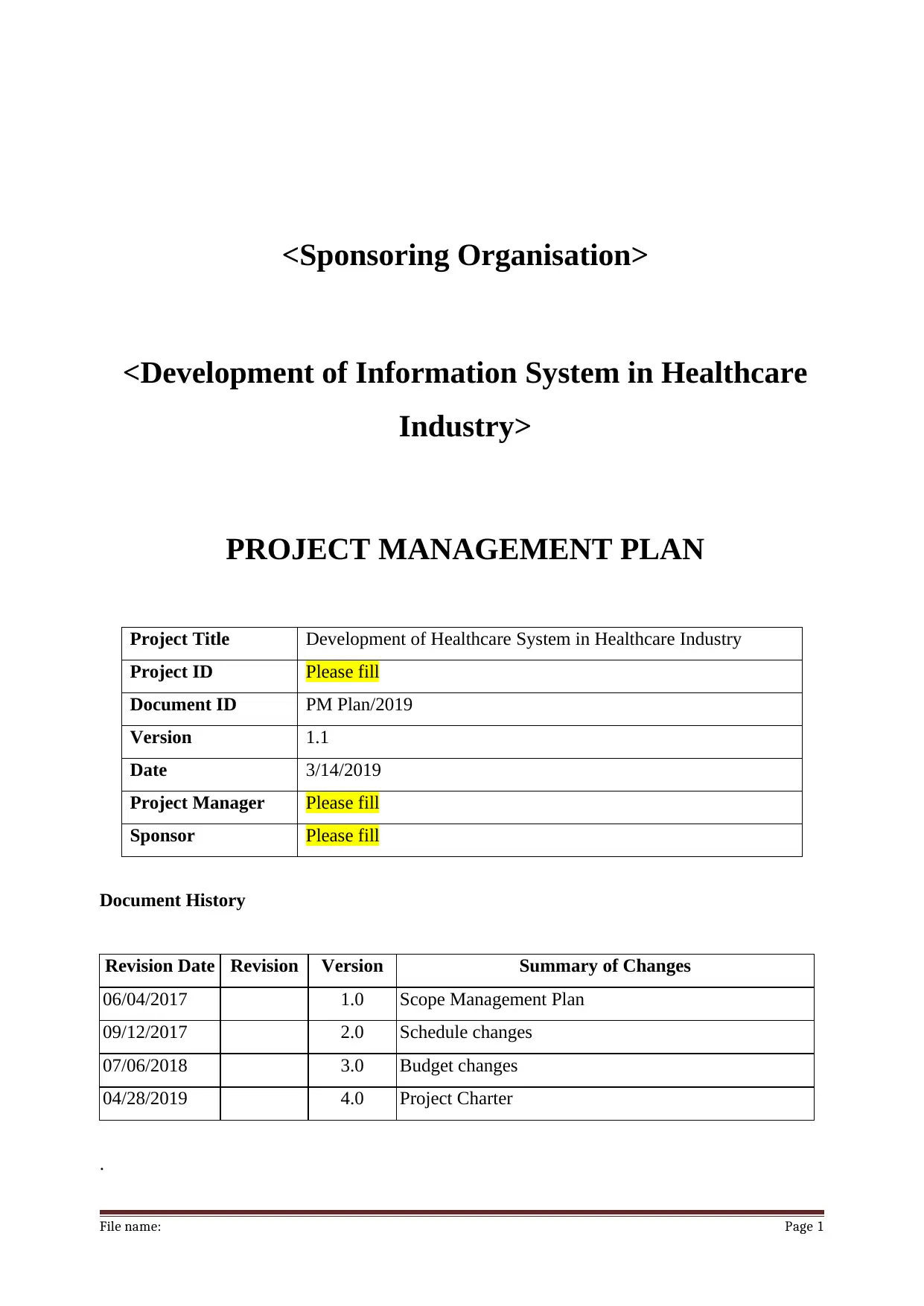
<Sponsoring Organisation>
<Development of Information System in Healthcare
Industry>
PROJECT MANAGEMENT PLAN
Project Title Development of Healthcare System in Healthcare Industry
Project ID Please fill
Document ID PM Plan/2019
Version 1.1
Date 3/14/2019
Project Manager Please fill
Sponsor Please fill
Document History
Revision Date Revision Version Summary of Changes
06/04/2017 1.0 Scope Management Plan
09/12/2017 2.0 Schedule changes
07/06/2018 3.0 Budget changes
04/28/2019 4.0 Project Charter
.
File name: Page 1
<Development of Information System in Healthcare
Industry>
PROJECT MANAGEMENT PLAN
Project Title Development of Healthcare System in Healthcare Industry
Project ID Please fill
Document ID PM Plan/2019
Version 1.1
Date 3/14/2019
Project Manager Please fill
Sponsor Please fill
Document History
Revision Date Revision Version Summary of Changes
06/04/2017 1.0 Scope Management Plan
09/12/2017 2.0 Schedule changes
07/06/2018 3.0 Budget changes
04/28/2019 4.0 Project Charter
.
File name: Page 1
Paraphrase This Document
Need a fresh take? Get an instant paraphrase of this document with our AI Paraphraser
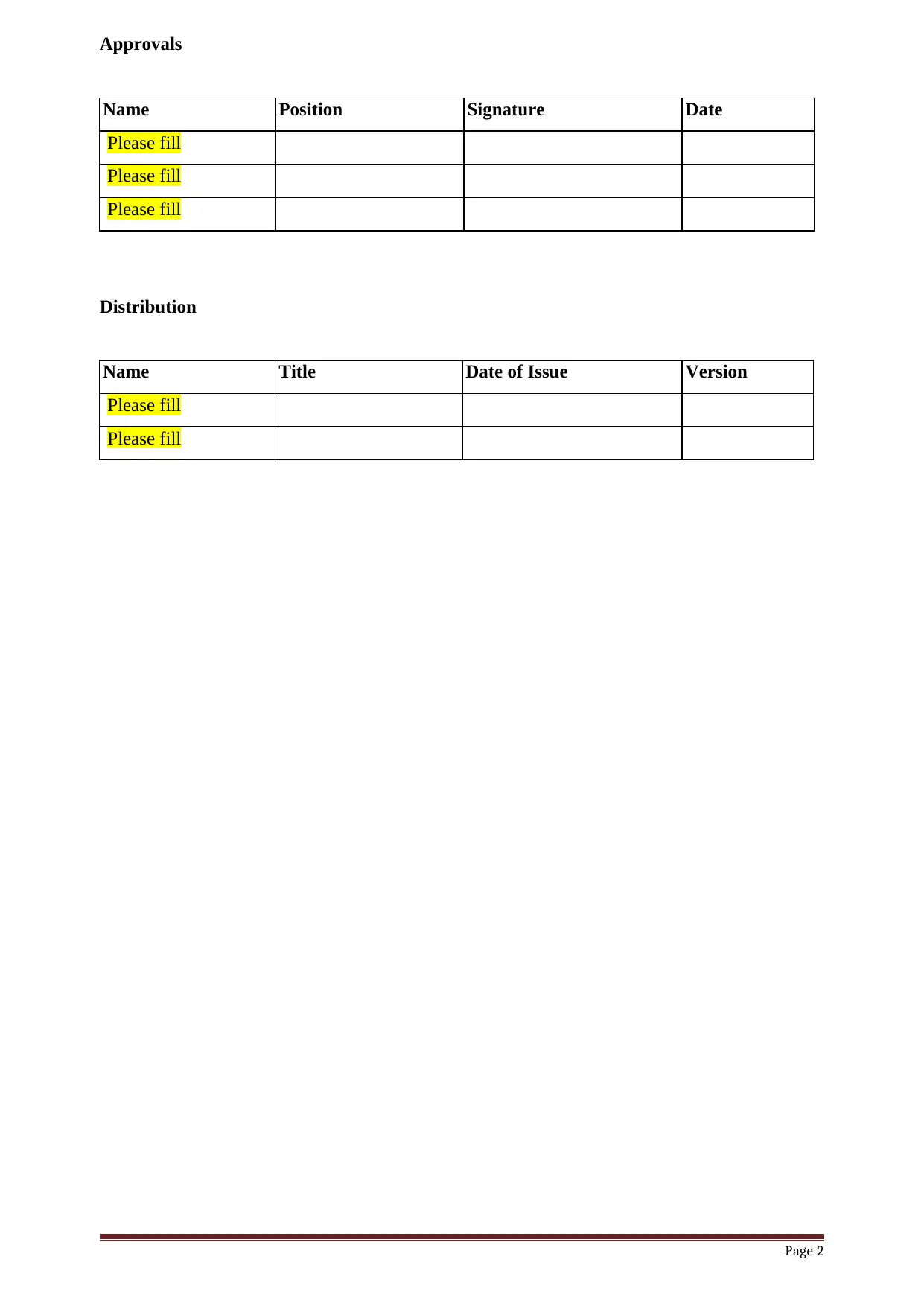
Approvals
Name Position Signature Date
Please fill
Please fill
Please fill
Distribution
Name Title Date of Issue Version
Please fill
Please fill
Page 2
Name Position Signature Date
Please fill
Please fill
Please fill
Distribution
Name Title Date of Issue Version
Please fill
Please fill
Page 2
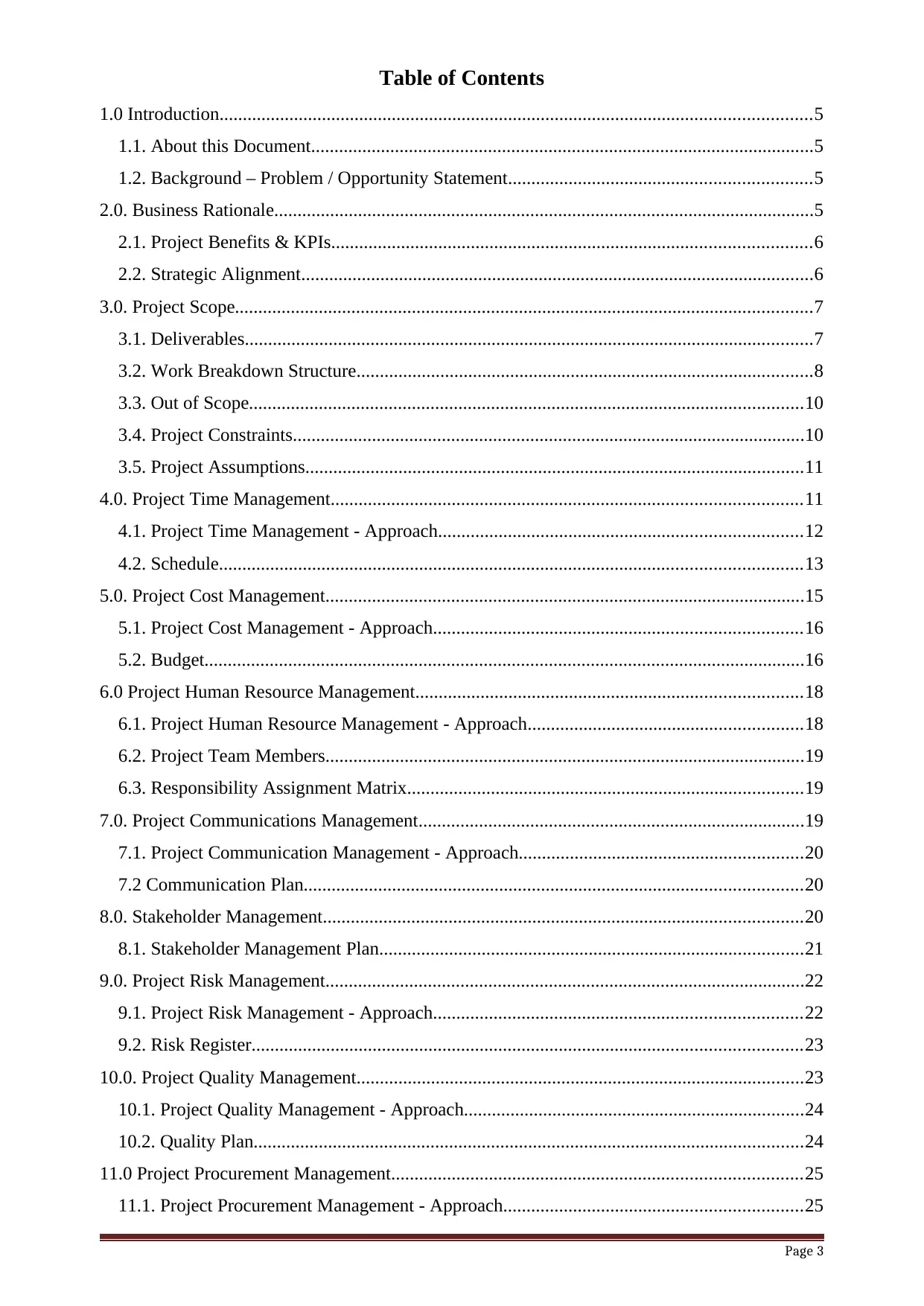
Table of Contents
1.0 Introduction...............................................................................................................................5
1.1. About this Document............................................................................................................5
1.2. Background – Problem / Opportunity Statement.................................................................5
2.0. Business Rationale....................................................................................................................5
2.1. Project Benefits & KPIs.......................................................................................................6
2.2. Strategic Alignment..............................................................................................................6
3.0. Project Scope............................................................................................................................7
3.1. Deliverables..........................................................................................................................7
3.2. Work Breakdown Structure..................................................................................................8
3.3. Out of Scope.......................................................................................................................10
3.4. Project Constraints..............................................................................................................10
3.5. Project Assumptions...........................................................................................................11
4.0. Project Time Management.....................................................................................................11
4.1. Project Time Management - Approach..............................................................................12
4.2. Schedule.............................................................................................................................13
5.0. Project Cost Management.......................................................................................................15
5.1. Project Cost Management - Approach...............................................................................16
5.2. Budget.................................................................................................................................16
6.0 Project Human Resource Management...................................................................................18
6.1. Project Human Resource Management - Approach...........................................................18
6.2. Project Team Members.......................................................................................................19
6.3. Responsibility Assignment Matrix.....................................................................................19
7.0. Project Communications Management...................................................................................19
7.1. Project Communication Management - Approach.............................................................20
7.2 Communication Plan...........................................................................................................20
8.0. Stakeholder Management.......................................................................................................20
8.1. Stakeholder Management Plan...........................................................................................21
9.0. Project Risk Management.......................................................................................................22
9.1. Project Risk Management - Approach...............................................................................22
9.2. Risk Register......................................................................................................................23
10.0. Project Quality Management................................................................................................23
10.1. Project Quality Management - Approach.........................................................................24
10.2. Quality Plan......................................................................................................................24
11.0 Project Procurement Management........................................................................................25
11.1. Project Procurement Management - Approach................................................................25
Page 3
1.0 Introduction...............................................................................................................................5
1.1. About this Document............................................................................................................5
1.2. Background – Problem / Opportunity Statement.................................................................5
2.0. Business Rationale....................................................................................................................5
2.1. Project Benefits & KPIs.......................................................................................................6
2.2. Strategic Alignment..............................................................................................................6
3.0. Project Scope............................................................................................................................7
3.1. Deliverables..........................................................................................................................7
3.2. Work Breakdown Structure..................................................................................................8
3.3. Out of Scope.......................................................................................................................10
3.4. Project Constraints..............................................................................................................10
3.5. Project Assumptions...........................................................................................................11
4.0. Project Time Management.....................................................................................................11
4.1. Project Time Management - Approach..............................................................................12
4.2. Schedule.............................................................................................................................13
5.0. Project Cost Management.......................................................................................................15
5.1. Project Cost Management - Approach...............................................................................16
5.2. Budget.................................................................................................................................16
6.0 Project Human Resource Management...................................................................................18
6.1. Project Human Resource Management - Approach...........................................................18
6.2. Project Team Members.......................................................................................................19
6.3. Responsibility Assignment Matrix.....................................................................................19
7.0. Project Communications Management...................................................................................19
7.1. Project Communication Management - Approach.............................................................20
7.2 Communication Plan...........................................................................................................20
8.0. Stakeholder Management.......................................................................................................20
8.1. Stakeholder Management Plan...........................................................................................21
9.0. Project Risk Management.......................................................................................................22
9.1. Project Risk Management - Approach...............................................................................22
9.2. Risk Register......................................................................................................................23
10.0. Project Quality Management................................................................................................23
10.1. Project Quality Management - Approach.........................................................................24
10.2. Quality Plan......................................................................................................................24
11.0 Project Procurement Management........................................................................................25
11.1. Project Procurement Management - Approach................................................................25
Page 3
⊘ This is a preview!⊘
Do you want full access?
Subscribe today to unlock all pages.

Trusted by 1+ million students worldwide
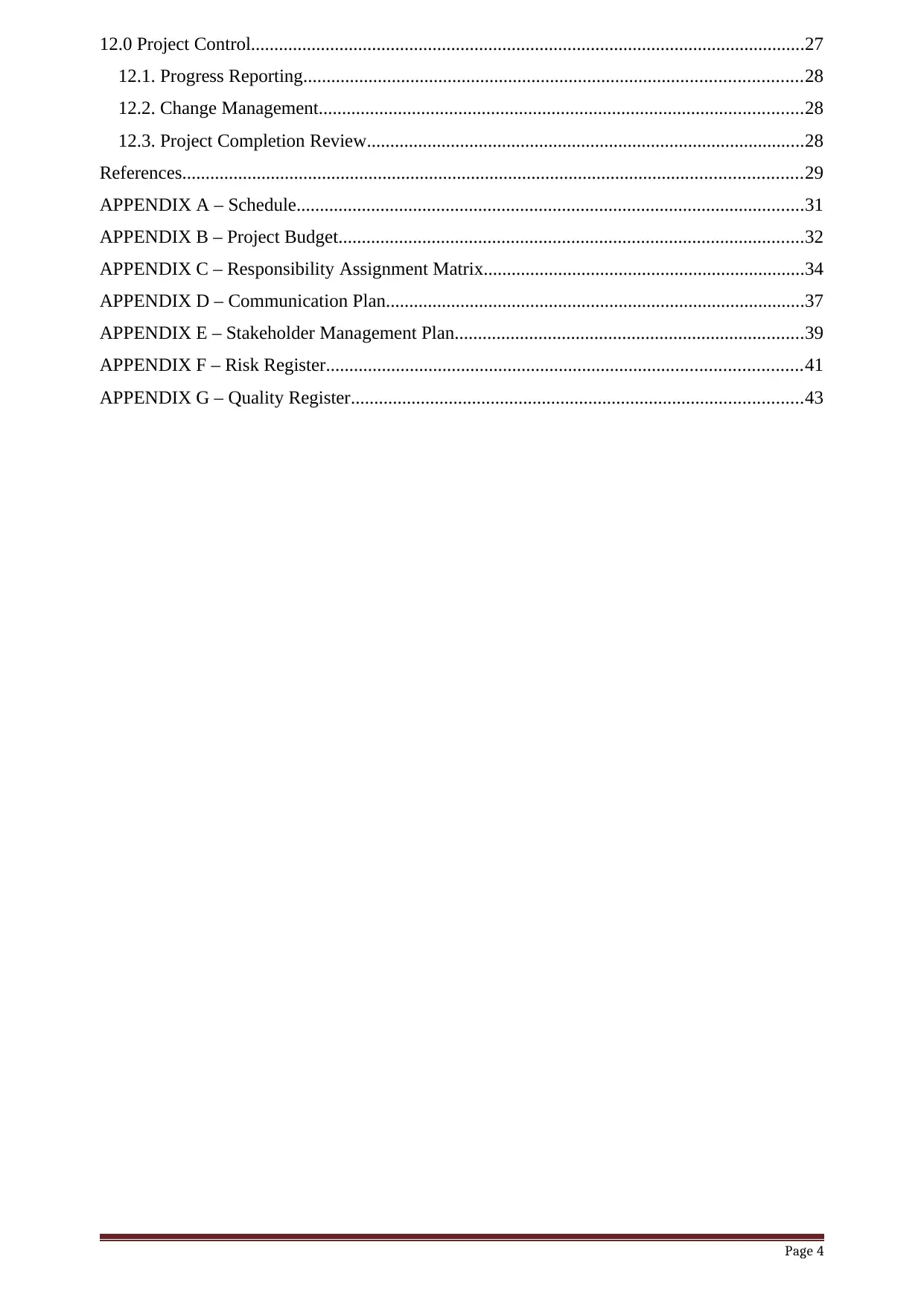
12.0 Project Control.......................................................................................................................27
12.1. Progress Reporting...........................................................................................................28
12.2. Change Management........................................................................................................28
12.3. Project Completion Review..............................................................................................28
References.....................................................................................................................................29
APPENDIX A – Schedule.............................................................................................................31
APPENDIX B – Project Budget....................................................................................................32
APPENDIX C – Responsibility Assignment Matrix.....................................................................34
APPENDIX D – Communication Plan..........................................................................................37
APPENDIX E – Stakeholder Management Plan...........................................................................39
APPENDIX F – Risk Register......................................................................................................41
APPENDIX G – Quality Register.................................................................................................43
Page 4
12.1. Progress Reporting...........................................................................................................28
12.2. Change Management........................................................................................................28
12.3. Project Completion Review..............................................................................................28
References.....................................................................................................................................29
APPENDIX A – Schedule.............................................................................................................31
APPENDIX B – Project Budget....................................................................................................32
APPENDIX C – Responsibility Assignment Matrix.....................................................................34
APPENDIX D – Communication Plan..........................................................................................37
APPENDIX E – Stakeholder Management Plan...........................................................................39
APPENDIX F – Risk Register......................................................................................................41
APPENDIX G – Quality Register.................................................................................................43
Page 4
Paraphrase This Document
Need a fresh take? Get an instant paraphrase of this document with our AI Paraphraser
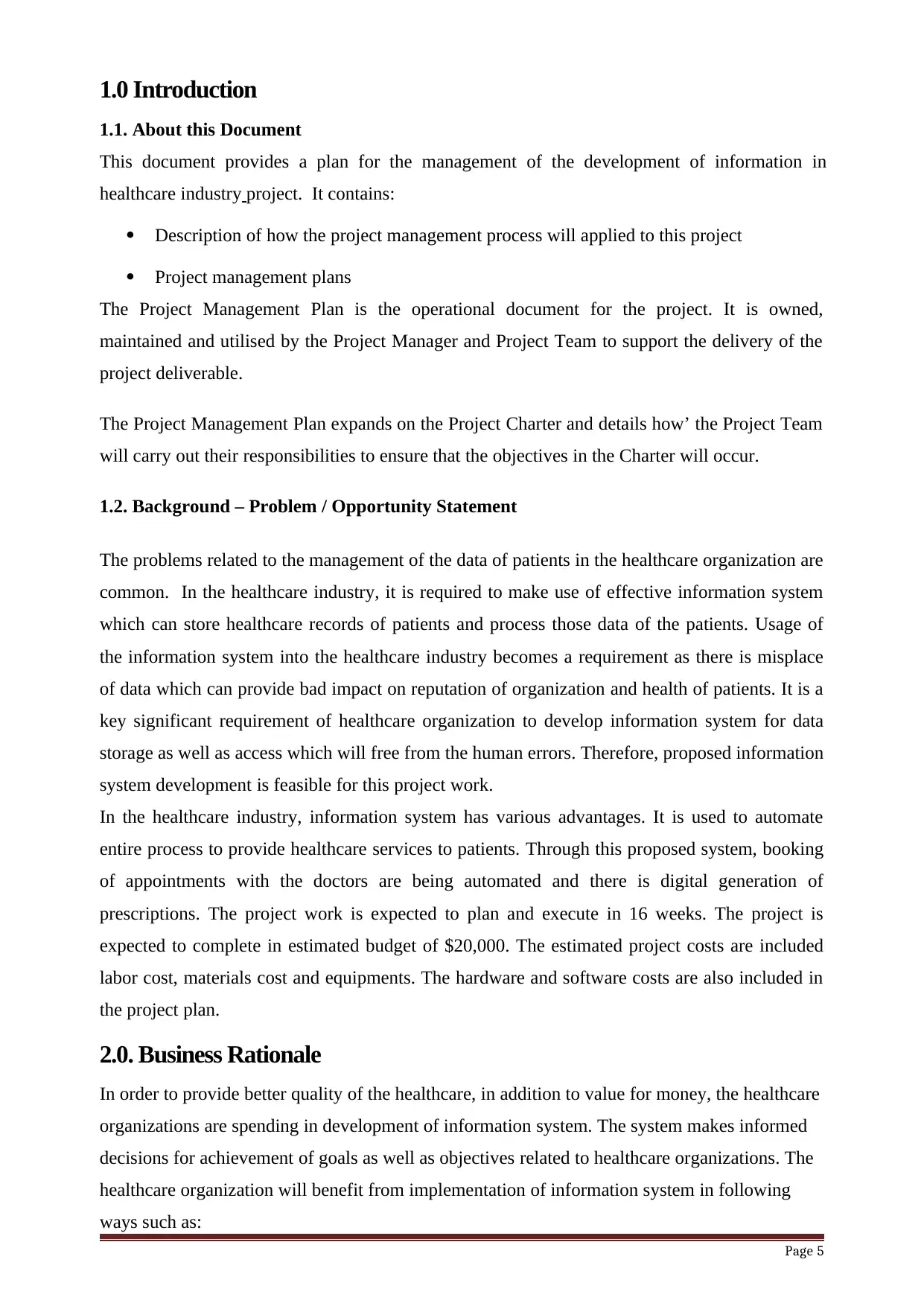
1.0 Introduction
1.1. About this Document
This document provides a plan for the management of the development of information in
healthcare industry project. It contains:
Description of how the project management process will applied to this project
Project management plans
The Project Management Plan is the operational document for the project. It is owned,
maintained and utilised by the Project Manager and Project Team to support the delivery of the
project deliverable.
The Project Management Plan expands on the Project Charter and details how’ the Project Team
will carry out their responsibilities to ensure that the objectives in the Charter will occur.
1.2. Background – Problem / Opportunity Statement
The problems related to the management of the data of patients in the healthcare organization are
common. In the healthcare industry, it is required to make use of effective information system
which can store healthcare records of patients and process those data of the patients. Usage of
the information system into the healthcare industry becomes a requirement as there is misplace
of data which can provide bad impact on reputation of organization and health of patients. It is a
key significant requirement of healthcare organization to develop information system for data
storage as well as access which will free from the human errors. Therefore, proposed information
system development is feasible for this project work.
In the healthcare industry, information system has various advantages. It is used to automate
entire process to provide healthcare services to patients. Through this proposed system, booking
of appointments with the doctors are being automated and there is digital generation of
prescriptions. The project work is expected to plan and execute in 16 weeks. The project is
expected to complete in estimated budget of $20,000. The estimated project costs are included
labor cost, materials cost and equipments. The hardware and software costs are also included in
the project plan.
2.0. Business Rationale
In order to provide better quality of the healthcare, in addition to value for money, the healthcare
organizations are spending in development of information system. The system makes informed
decisions for achievement of goals as well as objectives related to healthcare organizations. The
healthcare organization will benefit from implementation of information system in following
ways such as:
Page 5
1.1. About this Document
This document provides a plan for the management of the development of information in
healthcare industry project. It contains:
Description of how the project management process will applied to this project
Project management plans
The Project Management Plan is the operational document for the project. It is owned,
maintained and utilised by the Project Manager and Project Team to support the delivery of the
project deliverable.
The Project Management Plan expands on the Project Charter and details how’ the Project Team
will carry out their responsibilities to ensure that the objectives in the Charter will occur.
1.2. Background – Problem / Opportunity Statement
The problems related to the management of the data of patients in the healthcare organization are
common. In the healthcare industry, it is required to make use of effective information system
which can store healthcare records of patients and process those data of the patients. Usage of
the information system into the healthcare industry becomes a requirement as there is misplace
of data which can provide bad impact on reputation of organization and health of patients. It is a
key significant requirement of healthcare organization to develop information system for data
storage as well as access which will free from the human errors. Therefore, proposed information
system development is feasible for this project work.
In the healthcare industry, information system has various advantages. It is used to automate
entire process to provide healthcare services to patients. Through this proposed system, booking
of appointments with the doctors are being automated and there is digital generation of
prescriptions. The project work is expected to plan and execute in 16 weeks. The project is
expected to complete in estimated budget of $20,000. The estimated project costs are included
labor cost, materials cost and equipments. The hardware and software costs are also included in
the project plan.
2.0. Business Rationale
In order to provide better quality of the healthcare, in addition to value for money, the healthcare
organizations are spending in development of information system. The system makes informed
decisions for achievement of goals as well as objectives related to healthcare organizations. The
healthcare organization will benefit from implementation of information system in following
ways such as:
Page 5
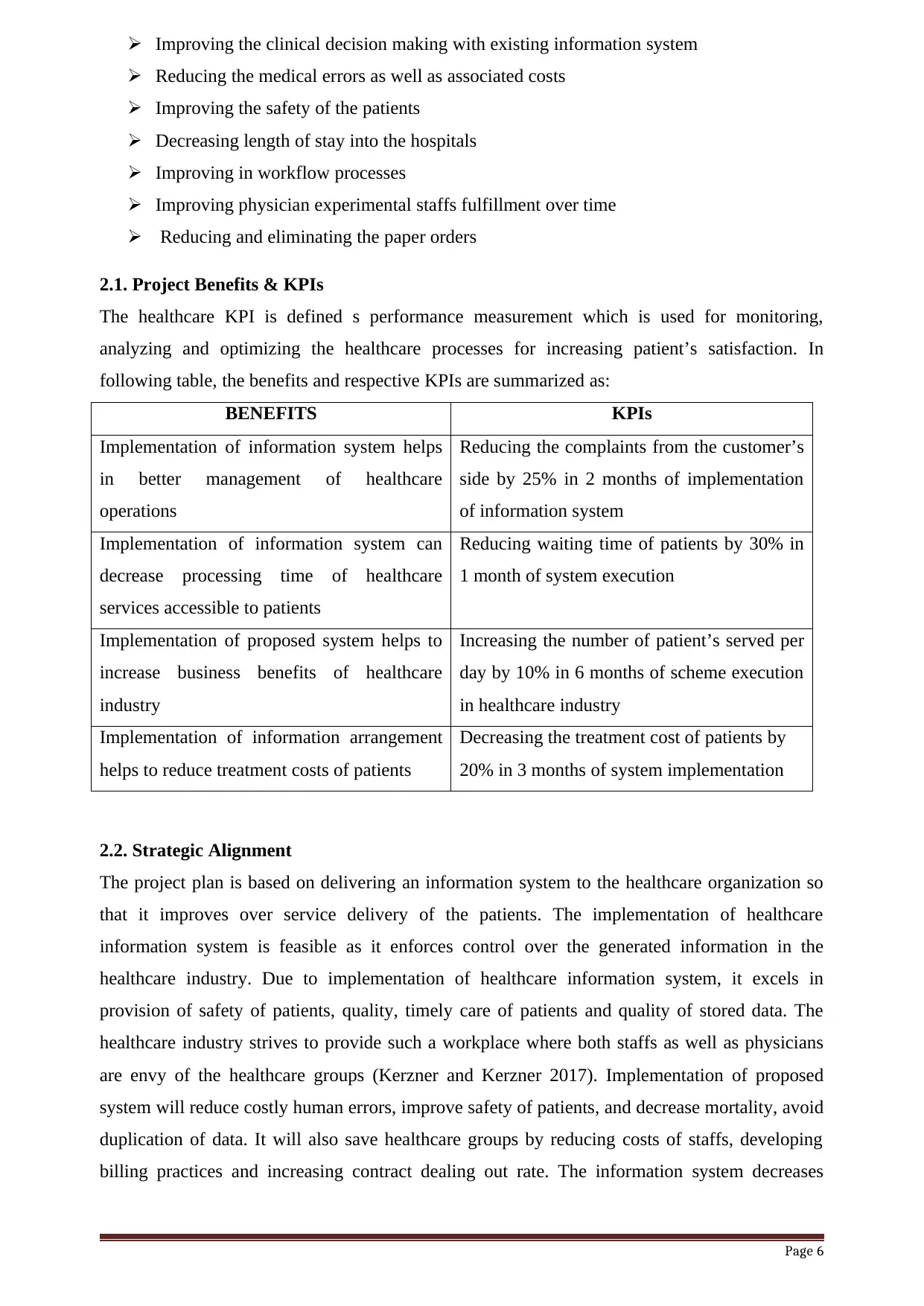
Improving the clinical decision making with existing information system
Reducing the medical errors as well as associated costs
Improving the safety of the patients
Decreasing length of stay into the hospitals
Improving in workflow processes
Improving physician experimental staffs fulfillment over time
Reducing and eliminating the paper orders
2.1. Project Benefits & KPIs
The healthcare KPI is defined s performance measurement which is used for monitoring,
analyzing and optimizing the healthcare processes for increasing patient’s satisfaction. In
following table, the benefits and respective KPIs are summarized as:
BENEFITS KPIs
Implementation of information system helps
in better management of healthcare
operations
Reducing the complaints from the customer’s
side by 25% in 2 months of implementation
of information system
Implementation of information system can
decrease processing time of healthcare
services accessible to patients
Reducing waiting time of patients by 30% in
1 month of system execution
Implementation of proposed system helps to
increase business benefits of healthcare
industry
Increasing the number of patient’s served per
day by 10% in 6 months of scheme execution
in healthcare industry
Implementation of information arrangement
helps to reduce treatment costs of patients
Decreasing the treatment cost of patients by
20% in 3 months of system implementation
2.2. Strategic Alignment
The project plan is based on delivering an information system to the healthcare organization so
that it improves over service delivery of the patients. The implementation of healthcare
information system is feasible as it enforces control over the generated information in the
healthcare industry. Due to implementation of healthcare information system, it excels in
provision of safety of patients, quality, timely care of patients and quality of stored data. The
healthcare industry strives to provide such a workplace where both staffs as well as physicians
are envy of the healthcare groups (Kerzner and Kerzner 2017). Implementation of proposed
system will reduce costly human errors, improve safety of patients, and decrease mortality, avoid
duplication of data. It will also save healthcare groups by reducing costs of staffs, developing
billing practices and increasing contract dealing out rate. The information system decreases
Page 6
Reducing the medical errors as well as associated costs
Improving the safety of the patients
Decreasing length of stay into the hospitals
Improving in workflow processes
Improving physician experimental staffs fulfillment over time
Reducing and eliminating the paper orders
2.1. Project Benefits & KPIs
The healthcare KPI is defined s performance measurement which is used for monitoring,
analyzing and optimizing the healthcare processes for increasing patient’s satisfaction. In
following table, the benefits and respective KPIs are summarized as:
BENEFITS KPIs
Implementation of information system helps
in better management of healthcare
operations
Reducing the complaints from the customer’s
side by 25% in 2 months of implementation
of information system
Implementation of information system can
decrease processing time of healthcare
services accessible to patients
Reducing waiting time of patients by 30% in
1 month of system execution
Implementation of proposed system helps to
increase business benefits of healthcare
industry
Increasing the number of patient’s served per
day by 10% in 6 months of scheme execution
in healthcare industry
Implementation of information arrangement
helps to reduce treatment costs of patients
Decreasing the treatment cost of patients by
20% in 3 months of system implementation
2.2. Strategic Alignment
The project plan is based on delivering an information system to the healthcare organization so
that it improves over service delivery of the patients. The implementation of healthcare
information system is feasible as it enforces control over the generated information in the
healthcare industry. Due to implementation of healthcare information system, it excels in
provision of safety of patients, quality, timely care of patients and quality of stored data. The
healthcare industry strives to provide such a workplace where both staffs as well as physicians
are envy of the healthcare groups (Kerzner and Kerzner 2017). Implementation of proposed
system will reduce costly human errors, improve safety of patients, and decrease mortality, avoid
duplication of data. It will also save healthcare groups by reducing costs of staffs, developing
billing practices and increasing contract dealing out rate. The information system decreases
Page 6
⊘ This is a preview!⊘
Do you want full access?
Subscribe today to unlock all pages.

Trusted by 1+ million students worldwide
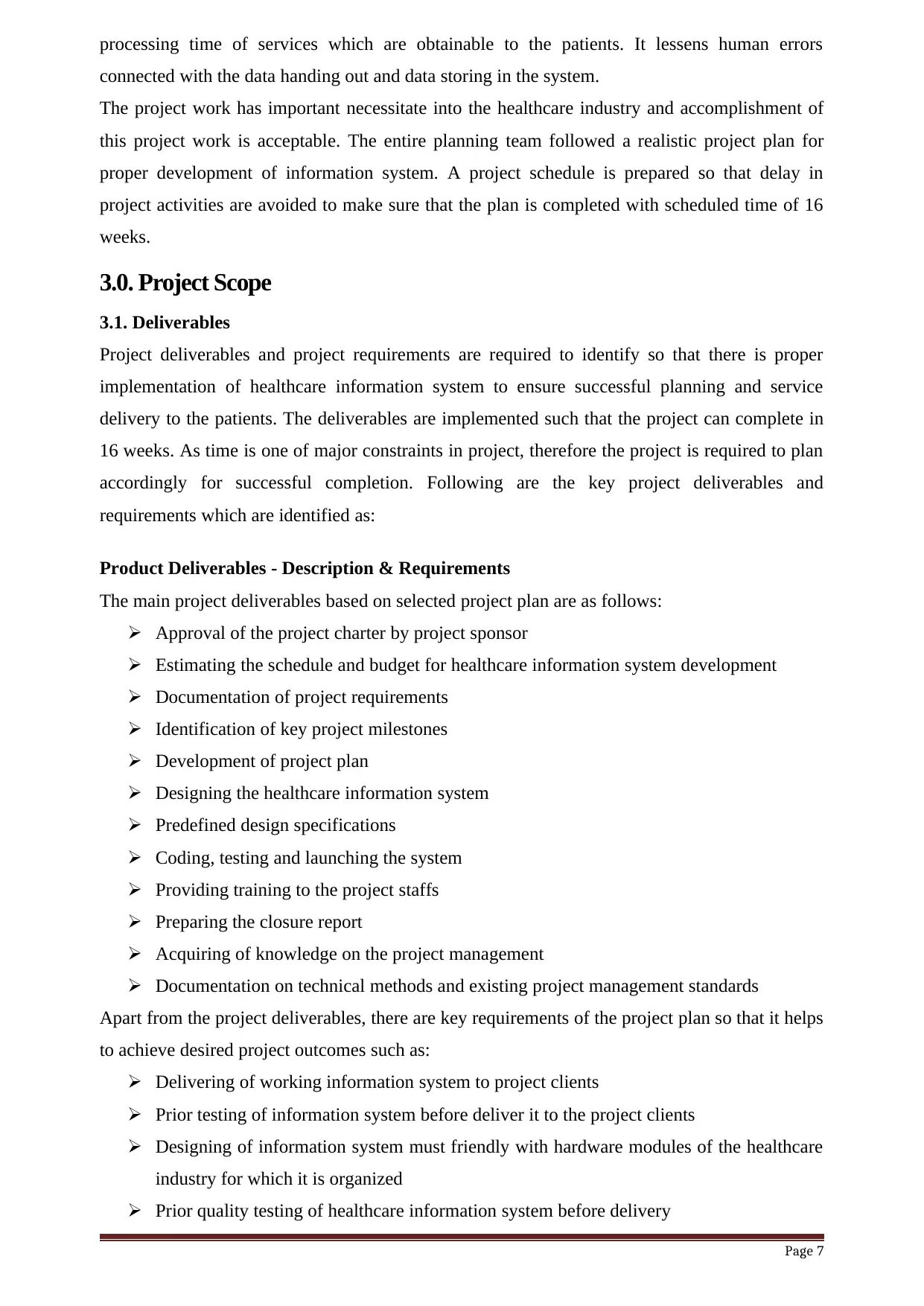
processing time of services which are obtainable to the patients. It lessens human errors
connected with the data handing out and data storing in the system.
The project work has important necessitate into the healthcare industry and accomplishment of
this project work is acceptable. The entire planning team followed a realistic project plan for
proper development of information system. A project schedule is prepared so that delay in
project activities are avoided to make sure that the plan is completed with scheduled time of 16
weeks.
3.0. Project Scope
3.1. Deliverables
Project deliverables and project requirements are required to identify so that there is proper
implementation of healthcare information system to ensure successful planning and service
delivery to the patients. The deliverables are implemented such that the project can complete in
16 weeks. As time is one of major constraints in project, therefore the project is required to plan
accordingly for successful completion. Following are the key project deliverables and
requirements which are identified as:
Product Deliverables - Description & Requirements
The main project deliverables based on selected project plan are as follows:
Approval of the project charter by project sponsor
Estimating the schedule and budget for healthcare information system development
Documentation of project requirements
Identification of key project milestones
Development of project plan
Designing the healthcare information system
Predefined design specifications
Coding, testing and launching the system
Providing training to the project staffs
Preparing the closure report
Acquiring of knowledge on the project management
Documentation on technical methods and existing project management standards
Apart from the project deliverables, there are key requirements of the project plan so that it helps
to achieve desired project outcomes such as:
Delivering of working information system to project clients
Prior testing of information system before deliver it to the project clients
Designing of information system must friendly with hardware modules of the healthcare
industry for which it is organized
Prior quality testing of healthcare information system before delivery
Page 7
connected with the data handing out and data storing in the system.
The project work has important necessitate into the healthcare industry and accomplishment of
this project work is acceptable. The entire planning team followed a realistic project plan for
proper development of information system. A project schedule is prepared so that delay in
project activities are avoided to make sure that the plan is completed with scheduled time of 16
weeks.
3.0. Project Scope
3.1. Deliverables
Project deliverables and project requirements are required to identify so that there is proper
implementation of healthcare information system to ensure successful planning and service
delivery to the patients. The deliverables are implemented such that the project can complete in
16 weeks. As time is one of major constraints in project, therefore the project is required to plan
accordingly for successful completion. Following are the key project deliverables and
requirements which are identified as:
Product Deliverables - Description & Requirements
The main project deliverables based on selected project plan are as follows:
Approval of the project charter by project sponsor
Estimating the schedule and budget for healthcare information system development
Documentation of project requirements
Identification of key project milestones
Development of project plan
Designing the healthcare information system
Predefined design specifications
Coding, testing and launching the system
Providing training to the project staffs
Preparing the closure report
Acquiring of knowledge on the project management
Documentation on technical methods and existing project management standards
Apart from the project deliverables, there are key requirements of the project plan so that it helps
to achieve desired project outcomes such as:
Delivering of working information system to project clients
Prior testing of information system before deliver it to the project clients
Designing of information system must friendly with hardware modules of the healthcare
industry for which it is organized
Prior quality testing of healthcare information system before delivery
Page 7
Paraphrase This Document
Need a fresh take? Get an instant paraphrase of this document with our AI Paraphraser
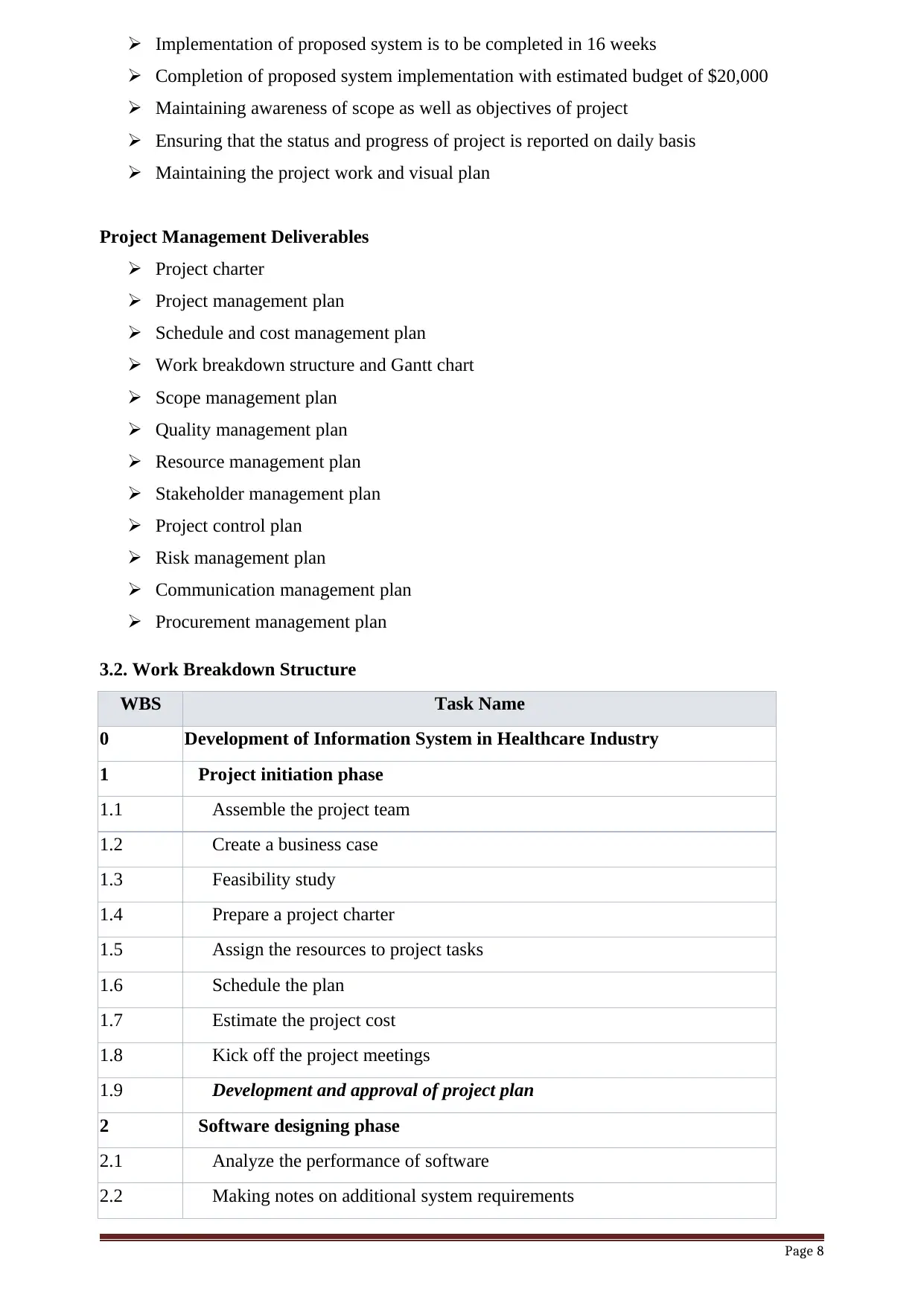
Implementation of proposed system is to be completed in 16 weeks
Completion of proposed system implementation with estimated budget of $20,000
Maintaining awareness of scope as well as objectives of project
Ensuring that the status and progress of project is reported on daily basis
Maintaining the project work and visual plan
Project Management Deliverables
Project charter
Project management plan
Schedule and cost management plan
Work breakdown structure and Gantt chart
Scope management plan
Quality management plan
Resource management plan
Stakeholder management plan
Project control plan
Risk management plan
Communication management plan
Procurement management plan
3.2. Work Breakdown Structure
WBS Task Name
0 Development of Information System in Healthcare Industry
1 Project initiation phase
1.1 Assemble the project team
1.2 Create a business case
1.3 Feasibility study
1.4 Prepare a project charter
1.5 Assign the resources to project tasks
1.6 Schedule the plan
1.7 Estimate the project cost
1.8 Kick off the project meetings
1.9 Development and approval of project plan
2 Software designing phase
2.1 Analyze the performance of software
2.2 Making notes on additional system requirements
Page 8
Completion of proposed system implementation with estimated budget of $20,000
Maintaining awareness of scope as well as objectives of project
Ensuring that the status and progress of project is reported on daily basis
Maintaining the project work and visual plan
Project Management Deliverables
Project charter
Project management plan
Schedule and cost management plan
Work breakdown structure and Gantt chart
Scope management plan
Quality management plan
Resource management plan
Stakeholder management plan
Project control plan
Risk management plan
Communication management plan
Procurement management plan
3.2. Work Breakdown Structure
WBS Task Name
0 Development of Information System in Healthcare Industry
1 Project initiation phase
1.1 Assemble the project team
1.2 Create a business case
1.3 Feasibility study
1.4 Prepare a project charter
1.5 Assign the resources to project tasks
1.6 Schedule the plan
1.7 Estimate the project cost
1.8 Kick off the project meetings
1.9 Development and approval of project plan
2 Software designing phase
2.1 Analyze the performance of software
2.2 Making notes on additional system requirements
Page 8
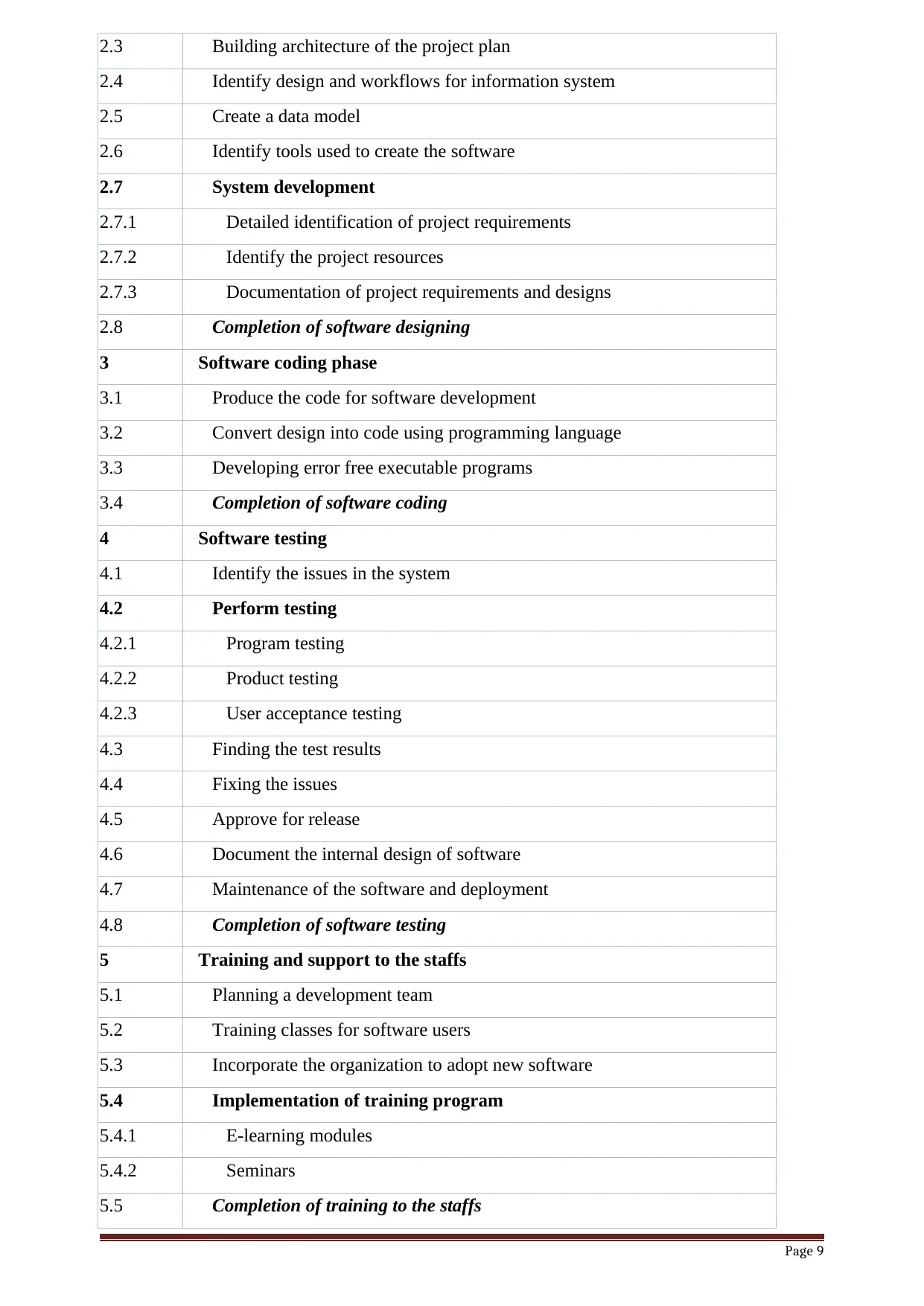
2.3 Building architecture of the project plan
2.4 Identify design and workflows for information system
2.5 Create a data model
2.6 Identify tools used to create the software
2.7 System development
2.7.1 Detailed identification of project requirements
2.7.2 Identify the project resources
2.7.3 Documentation of project requirements and designs
2.8 Completion of software designing
3 Software coding phase
3.1 Produce the code for software development
3.2 Convert design into code using programming language
3.3 Developing error free executable programs
3.4 Completion of software coding
4 Software testing
4.1 Identify the issues in the system
4.2 Perform testing
4.2.1 Program testing
4.2.2 Product testing
4.2.3 User acceptance testing
4.3 Finding the test results
4.4 Fixing the issues
4.5 Approve for release
4.6 Document the internal design of software
4.7 Maintenance of the software and deployment
4.8 Completion of software testing
5 Training and support to the staffs
5.1 Planning a development team
5.2 Training classes for software users
5.3 Incorporate the organization to adopt new software
5.4 Implementation of training program
5.4.1 E-learning modules
5.4.2 Seminars
5.5 Completion of training to the staffs
Page 9
2.4 Identify design and workflows for information system
2.5 Create a data model
2.6 Identify tools used to create the software
2.7 System development
2.7.1 Detailed identification of project requirements
2.7.2 Identify the project resources
2.7.3 Documentation of project requirements and designs
2.8 Completion of software designing
3 Software coding phase
3.1 Produce the code for software development
3.2 Convert design into code using programming language
3.3 Developing error free executable programs
3.4 Completion of software coding
4 Software testing
4.1 Identify the issues in the system
4.2 Perform testing
4.2.1 Program testing
4.2.2 Product testing
4.2.3 User acceptance testing
4.3 Finding the test results
4.4 Fixing the issues
4.5 Approve for release
4.6 Document the internal design of software
4.7 Maintenance of the software and deployment
4.8 Completion of software testing
5 Training and support to the staffs
5.1 Planning a development team
5.2 Training classes for software users
5.3 Incorporate the organization to adopt new software
5.4 Implementation of training program
5.4.1 E-learning modules
5.4.2 Seminars
5.5 Completion of training to the staffs
Page 9
⊘ This is a preview!⊘
Do you want full access?
Subscribe today to unlock all pages.

Trusted by 1+ million students worldwide
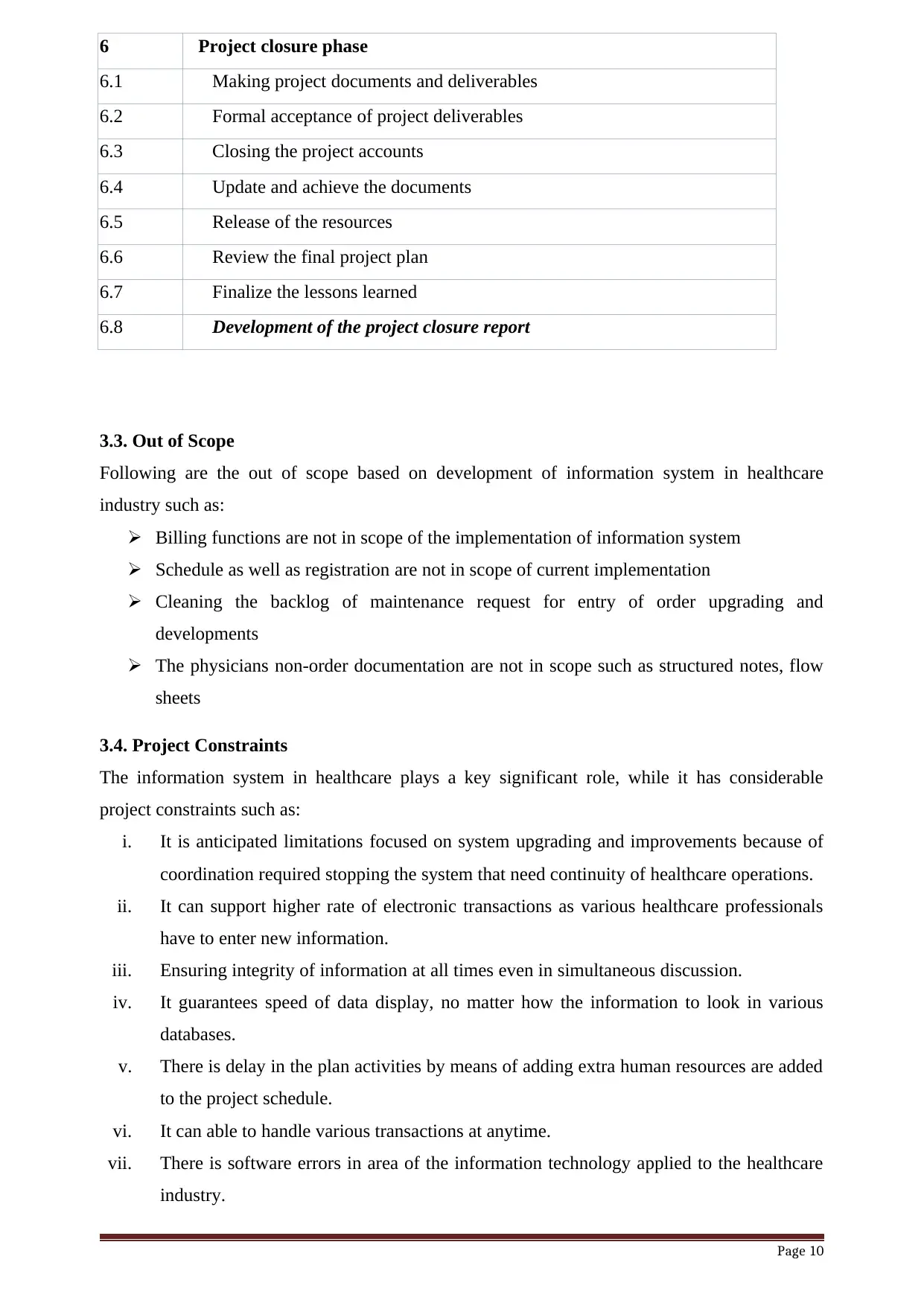
6 Project closure phase
6.1 Making project documents and deliverables
6.2 Formal acceptance of project deliverables
6.3 Closing the project accounts
6.4 Update and achieve the documents
6.5 Release of the resources
6.6 Review the final project plan
6.7 Finalize the lessons learned
6.8 Development of the project closure report
3.3. Out of Scope
Following are the out of scope based on development of information system in healthcare
industry such as:
Billing functions are not in scope of the implementation of information system
Schedule as well as registration are not in scope of current implementation
Cleaning the backlog of maintenance request for entry of order upgrading and
developments
The physicians non-order documentation are not in scope such as structured notes, flow
sheets
3.4. Project Constraints
The information system in healthcare plays a key significant role, while it has considerable
project constraints such as:
i. It is anticipated limitations focused on system upgrading and improvements because of
coordination required stopping the system that need continuity of healthcare operations.
ii. It can support higher rate of electronic transactions as various healthcare professionals
have to enter new information.
iii. Ensuring integrity of information at all times even in simultaneous discussion.
iv. It guarantees speed of data display, no matter how the information to look in various
databases.
v. There is delay in the plan activities by means of adding extra human resources are added
to the project schedule.
vi. It can able to handle various transactions at anytime.
vii. There is software errors in area of the information technology applied to the healthcare
industry.
Page 10
6.1 Making project documents and deliverables
6.2 Formal acceptance of project deliverables
6.3 Closing the project accounts
6.4 Update and achieve the documents
6.5 Release of the resources
6.6 Review the final project plan
6.7 Finalize the lessons learned
6.8 Development of the project closure report
3.3. Out of Scope
Following are the out of scope based on development of information system in healthcare
industry such as:
Billing functions are not in scope of the implementation of information system
Schedule as well as registration are not in scope of current implementation
Cleaning the backlog of maintenance request for entry of order upgrading and
developments
The physicians non-order documentation are not in scope such as structured notes, flow
sheets
3.4. Project Constraints
The information system in healthcare plays a key significant role, while it has considerable
project constraints such as:
i. It is anticipated limitations focused on system upgrading and improvements because of
coordination required stopping the system that need continuity of healthcare operations.
ii. It can support higher rate of electronic transactions as various healthcare professionals
have to enter new information.
iii. Ensuring integrity of information at all times even in simultaneous discussion.
iv. It guarantees speed of data display, no matter how the information to look in various
databases.
v. There is delay in the plan activities by means of adding extra human resources are added
to the project schedule.
vi. It can able to handle various transactions at anytime.
vii. There is software errors in area of the information technology applied to the healthcare
industry.
Page 10
Paraphrase This Document
Need a fresh take? Get an instant paraphrase of this document with our AI Paraphraser
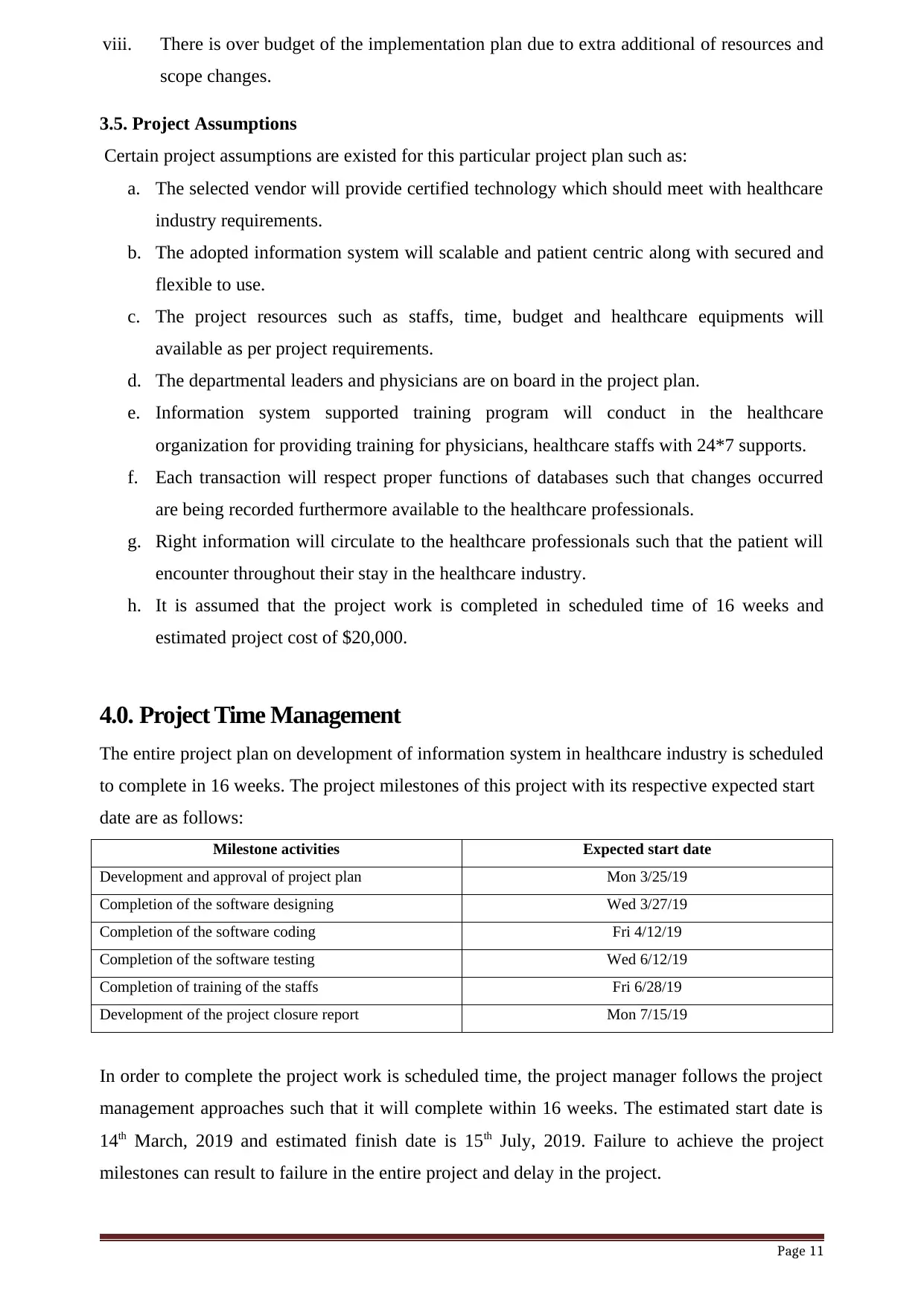
viii. There is over budget of the implementation plan due to extra additional of resources and
scope changes.
3.5. Project Assumptions
Certain project assumptions are existed for this particular project plan such as:
a. The selected vendor will provide certified technology which should meet with healthcare
industry requirements.
b. The adopted information system will scalable and patient centric along with secured and
flexible to use.
c. The project resources such as staffs, time, budget and healthcare equipments will
available as per project requirements.
d. The departmental leaders and physicians are on board in the project plan.
e. Information system supported training program will conduct in the healthcare
organization for providing training for physicians, healthcare staffs with 24*7 supports.
f. Each transaction will respect proper functions of databases such that changes occurred
are being recorded furthermore available to the healthcare professionals.
g. Right information will circulate to the healthcare professionals such that the patient will
encounter throughout their stay in the healthcare industry.
h. It is assumed that the project work is completed in scheduled time of 16 weeks and
estimated project cost of $20,000.
4.0. Project Time Management
The entire project plan on development of information system in healthcare industry is scheduled
to complete in 16 weeks. The project milestones of this project with its respective expected start
date are as follows:
Milestone activities Expected start date
Development and approval of project plan Mon 3/25/19
Completion of the software designing Wed 3/27/19
Completion of the software coding Fri 4/12/19
Completion of the software testing Wed 6/12/19
Completion of training of the staffs Fri 6/28/19
Development of the project closure report Mon 7/15/19
In order to complete the project work is scheduled time, the project manager follows the project
management approaches such that it will complete within 16 weeks. The estimated start date is
14th March, 2019 and estimated finish date is 15th July, 2019. Failure to achieve the project
milestones can result to failure in the entire project and delay in the project.
Page 11
scope changes.
3.5. Project Assumptions
Certain project assumptions are existed for this particular project plan such as:
a. The selected vendor will provide certified technology which should meet with healthcare
industry requirements.
b. The adopted information system will scalable and patient centric along with secured and
flexible to use.
c. The project resources such as staffs, time, budget and healthcare equipments will
available as per project requirements.
d. The departmental leaders and physicians are on board in the project plan.
e. Information system supported training program will conduct in the healthcare
organization for providing training for physicians, healthcare staffs with 24*7 supports.
f. Each transaction will respect proper functions of databases such that changes occurred
are being recorded furthermore available to the healthcare professionals.
g. Right information will circulate to the healthcare professionals such that the patient will
encounter throughout their stay in the healthcare industry.
h. It is assumed that the project work is completed in scheduled time of 16 weeks and
estimated project cost of $20,000.
4.0. Project Time Management
The entire project plan on development of information system in healthcare industry is scheduled
to complete in 16 weeks. The project milestones of this project with its respective expected start
date are as follows:
Milestone activities Expected start date
Development and approval of project plan Mon 3/25/19
Completion of the software designing Wed 3/27/19
Completion of the software coding Fri 4/12/19
Completion of the software testing Wed 6/12/19
Completion of training of the staffs Fri 6/28/19
Development of the project closure report Mon 7/15/19
In order to complete the project work is scheduled time, the project manager follows the project
management approaches such that it will complete within 16 weeks. The estimated start date is
14th March, 2019 and estimated finish date is 15th July, 2019. Failure to achieve the project
milestones can result to failure in the entire project and delay in the project.
Page 11

4.1. Project Time Management - Approach
At the project management stages based on development of information system in healthcare
industry, the project manager outlines following main six stages for conducting work in this
project plan such as:
Stage 1: Development and approval of project plan
This stage is based on when the project plans are documented, project deliverables, project
requirements are defined and creation of project schedule and budget plan. In this stage, the
project resources are assigned with project tasks based on their skills and knowledge. It is
involved to set plans for helping the team throughout implementation to closure project phases.
The plan is created which help to manage time, risk, and cost and scope changes (Schwalbe
2015). This phase helps to control the staffs as well as external suppliers to make certain that the
project is finished on instance in addition to budget.
Stage 2: Software designing
In this software development phase, the information system is prepared from system requirement
specifications. System design helps to specify both hardware as well as system requirements and
help to define the system architecture. Design specifications of system serves as input for next
phase. The technical details related to system design are being discussed with the project
stakeholders (Fleming and Koppelman 2016). Both time as well as design is reviewed as design
approach for the information system development.
Stage 3: Software coding
After receiving the documents on system design, actual coding of the software is started. Code is
formed which is main spotlight for the software developer. It is best phase of software
development life cycle. The developers started coding of software based on design requirements
(Heagney 2016). The database admin creates data into the database and code the software using
programming languages.
Stage 4: Software testing
The testing is done for new code which the developer has written, reviews the code, creates,
builds, as well as deploys the software to the business environment. The software testing is
repeated until the project requirements are to meet (Walker 2015). The testing is performed for
the software such as program testing, product testing and user acceptance testing.
Stage 5: Training and support of the staffs
Once the customers are started by means of developed system, then actual issues are required to
solve from time to time. This requires training the staffs regarding technical work for
development of information system. Seminars and workshops are conducted for providing
training to the system users and physicians (Harrison and Lock 2017). The healthcare
organization is being incorporated to implement new system in the business operations.
Page 12
At the project management stages based on development of information system in healthcare
industry, the project manager outlines following main six stages for conducting work in this
project plan such as:
Stage 1: Development and approval of project plan
This stage is based on when the project plans are documented, project deliverables, project
requirements are defined and creation of project schedule and budget plan. In this stage, the
project resources are assigned with project tasks based on their skills and knowledge. It is
involved to set plans for helping the team throughout implementation to closure project phases.
The plan is created which help to manage time, risk, and cost and scope changes (Schwalbe
2015). This phase helps to control the staffs as well as external suppliers to make certain that the
project is finished on instance in addition to budget.
Stage 2: Software designing
In this software development phase, the information system is prepared from system requirement
specifications. System design helps to specify both hardware as well as system requirements and
help to define the system architecture. Design specifications of system serves as input for next
phase. The technical details related to system design are being discussed with the project
stakeholders (Fleming and Koppelman 2016). Both time as well as design is reviewed as design
approach for the information system development.
Stage 3: Software coding
After receiving the documents on system design, actual coding of the software is started. Code is
formed which is main spotlight for the software developer. It is best phase of software
development life cycle. The developers started coding of software based on design requirements
(Heagney 2016). The database admin creates data into the database and code the software using
programming languages.
Stage 4: Software testing
The testing is done for new code which the developer has written, reviews the code, creates,
builds, as well as deploys the software to the business environment. The software testing is
repeated until the project requirements are to meet (Walker 2015). The testing is performed for
the software such as program testing, product testing and user acceptance testing.
Stage 5: Training and support of the staffs
Once the customers are started by means of developed system, then actual issues are required to
solve from time to time. This requires training the staffs regarding technical work for
development of information system. Seminars and workshops are conducted for providing
training to the system users and physicians (Harrison and Lock 2017). The healthcare
organization is being incorporated to implement new system in the business operations.
Page 12
⊘ This is a preview!⊘
Do you want full access?
Subscribe today to unlock all pages.

Trusted by 1+ million students worldwide
1 out of 44
Related Documents
Your All-in-One AI-Powered Toolkit for Academic Success.
+13062052269
info@desklib.com
Available 24*7 on WhatsApp / Email
![[object Object]](/_next/static/media/star-bottom.7253800d.svg)
Unlock your academic potential
Copyright © 2020–2025 A2Z Services. All Rights Reserved. Developed and managed by ZUCOL.





